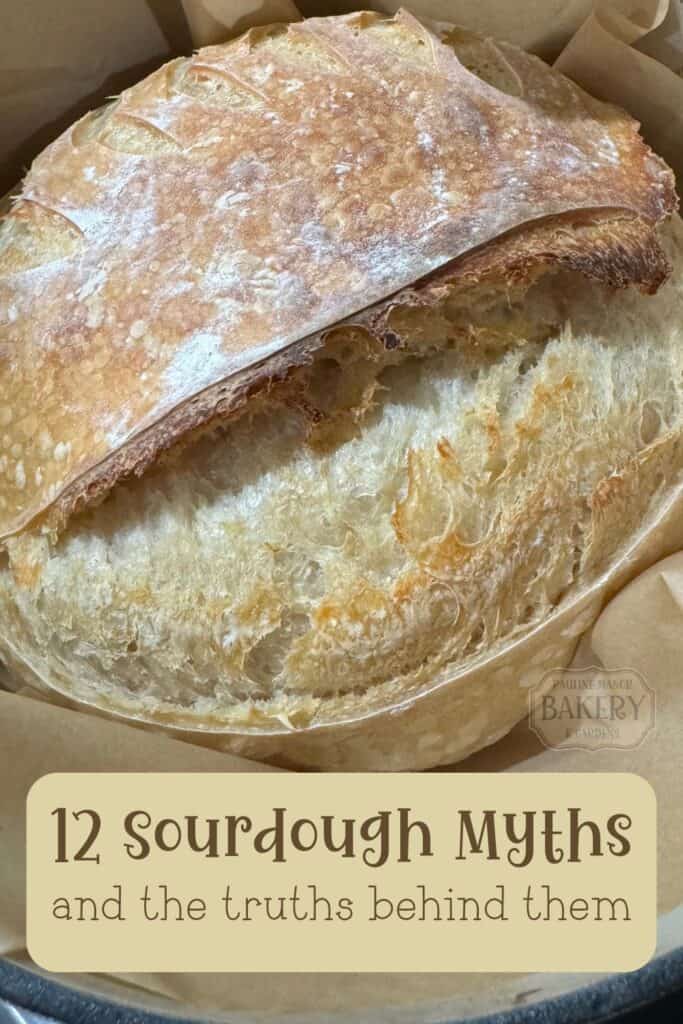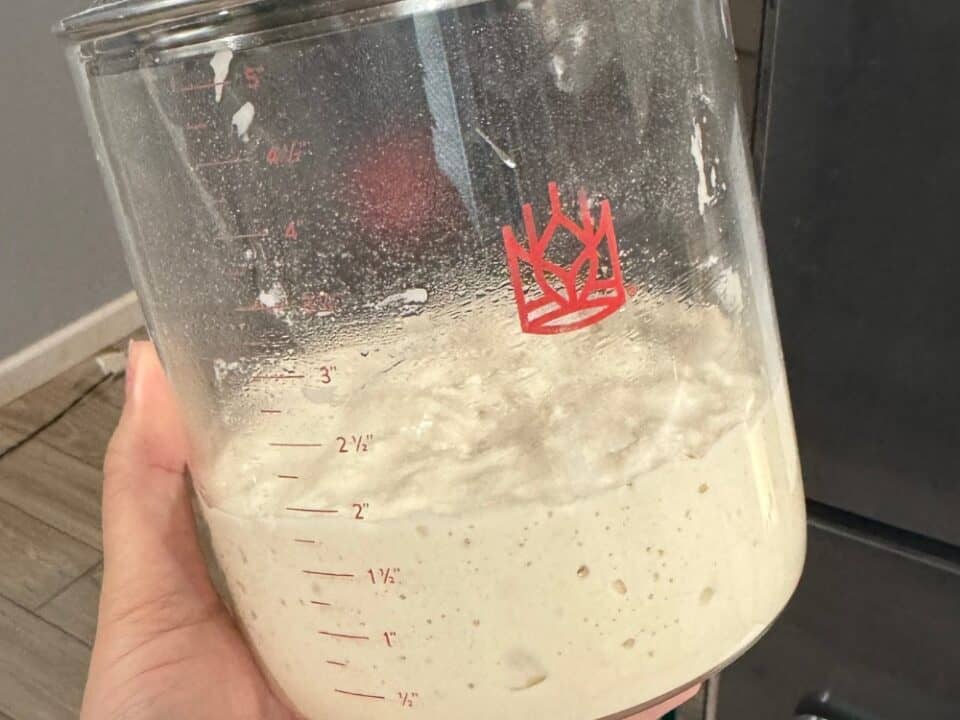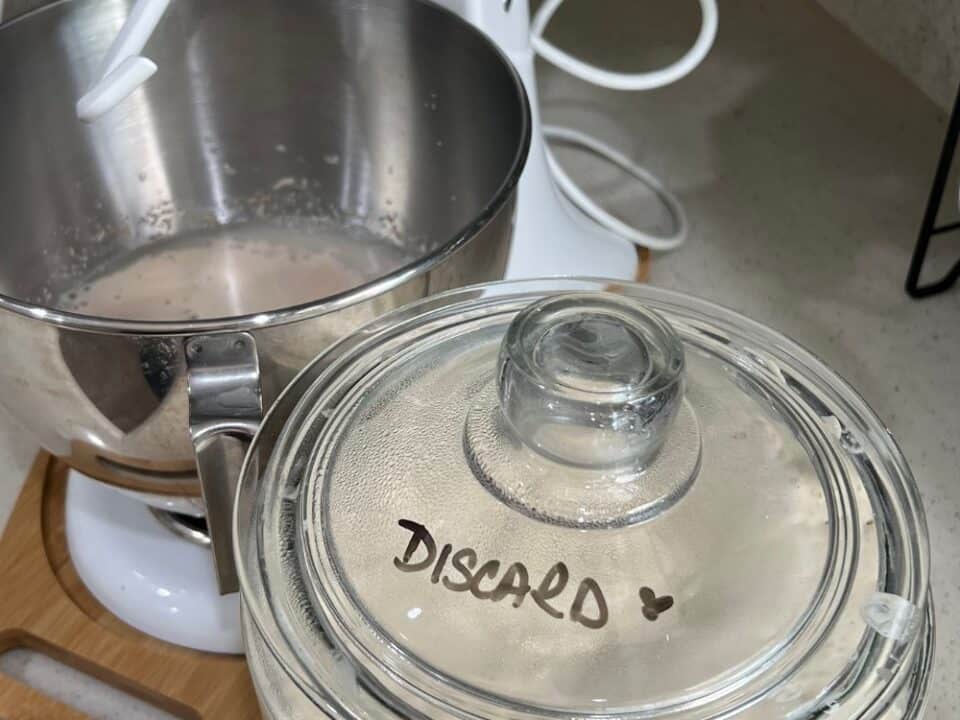12 Common Sourdough Myths—And the Truth Behind Them
If you’ve ever been curious about making sourdough but felt intimidated, you’re not alone. There’s a lot of advice out there, and unfortunately, a lot of misinformation too. So let’s break down some of the most common sourdough myths that tend to scare people off or make the process seem way more complicated than it actually is.

You have to use fancy flour to make good sourdough.
You really don’t. A lot of recipes and videos will suggest using organic, stone-ground, or specialty flours—and those are great if you want to experiment with flavor or nutrition. But basic, store-brand all-purpose flour works just fine. Many bakers start and maintain perfectly healthy starters with it and bake delicious bread. Don’t feel like you have to spend extra money on “artisan” flour unless you want to.
That being said, I do suggest using a bread flour when making classic sourdough loaves – especially as a beginner. Bred flour has just a bit more protein content, which means it creates more gluten when mixed and kneaded. That extra gluten gives bread more structure and chew, and helps it rise higher. You can bake great sourdough with either one. Bread flour might give you a bit more height and elasticity, while all-purpose can make a loaf that’s a little more relaxed and rustic.
Check out this post about the Best Flour For Sourdough.
Sourdough is too hard for beginners.
It’s true that sourdough is different from using commercial yeast, and that there’s a learning curve. But that doesn’t mean it’s too hard. It’s just new. Once you understand the basic steps—feeding your starter, mixing the dough, letting it rise, and baking—you’ll realize it’s mostly about timing and observation. Your first few loaves might not turn out perfectly, and that’s totally normal. But each time, you’ll learn something new and get a little better.
Embrace the process and make sure to take pictures of your loaves each time so you can see the progression. The good news is that even the ugliest of sourdough still tastes delicious.
You need to feed your starter every single day forever.
Only if you’re baking every day. When you’re keeping your starter at room temperature, yes, it needs to be fed daily. But most homebakers don’t bake daily, and that’s where the fridge becomes your best friend. You can store your starter in the fridge and feed it once a week—some say even less often if you’re not using it regularly. Keeping your starter healthy is much more manageable than people think.
What is important to remember is that you do not feed your sourdough when it is cold and that you give it a chance to rise before tossing it back into the fridge. Well, that and that you do not forget about it in the back of the fridge for months on end. Even though I have heard stories of starter revivals… I still don't recommend it.
Check out my Complete Guide to Sourdough Starter to learn how to keep your starter in tip-top shape.
Sourdough is always super sour.
Not all sourdough is overly tangy. The sour flavor comes from lactic acid and acetic acid produced during fermentation, and you can actually control how sour your bread tastes. Shorter fermentation times, warmer temperatures, and feeding your starter more often can lead to a milder flavor. If you like your bread more sour, you can adjust your process to encourage that. But it’s not a given that every sourdough loaf will taste like vinegar.
There are some terrific “same day” sourdough loaf recipes that give you a beautiful light, fluffy bread with the classic chewy crust. However, those recipes do not result in a very tangy loaf of bread. Refrigerating overnight – or even over two nights – can help you to really achieve that beloved tang.
You have to discard your starter every time you feed it.
The term “discard” sounds wasteful, but it’s just part of keeping your starter in balance. If you never remove any, your starter would grow and grow and require more and more flour to stay active. The good news is, you don’t have to throw it away. Discard can be saved and used in recipes like pancakes, waffles, crackers, muffins, and more. It’s not trash—it’s just unfed starter that still has plenty of life in it.
Some people even keep a separate container in the fridge just for discard, adding to it each time they feed their starter. It can build up quickly, especially when you’re maintaining your starter regularly, so having easy ways to use it helps cut down on waste. You can use discard in both sweet and savory recipes, and because it’s not fully active, it won’t make your baked goods rise much—but it will add great flavor and a bit of tang. If you’re not ready to use it right away, discard can be stored in the fridge for up to a week or even frozen for later.
You can only bake sourdough in a Dutch oven.
Dutch ovens are great because they trap steam and help create that beautiful crust, but they’re not the only option. You can use a cast iron skillet with an inverted metal bowl, a loaf pan covered with foil, or even a baking stone with a pan of water for steam. If you don’t have a Dutch oven, don’t let that stop you. Work with what you have and adjust your technique as needed.
What matters most is creating a steamy environment during the first part of the bake—that’s what helps your loaf rise well and develop a crispy crust. Without steam, the crust sets too early and can limit oven spring. If you’re baking on a cookie sheet or pan without a lid, try adding a small metal dish of hot water to the bottom rack or misting the oven with water right after loading your dough. It won’t be exactly the same as a Dutch oven, but it still works—and you’ll get a beautiful, homemade sourdough loaf using what’s already in your kitchen.
You can’t bake sourdough if you have a full-time job.
You absolutely can. The trick is to adapt the process to your schedule. Many steps in sourdough baking are hands-off and can happen overnight or while you’re at work. For example, you can mix your dough in the morning, shape it in the evening, and let it rise overnight in the fridge to bake the next day. There’s no one-size-fits-all timeline. You can find a rhythm that works for you.
Cold fermentation is especially helpful for busy schedules—it slows everything down and gives you more flexibility. Once your dough is shaped and in its proofing basket or bowl, you can pop it in the fridge and leave it there for up to 48 hours before baking. That means you can do most of the work on your own time, then bake when it fits your day. Sourdough doesn’t have to take over your life—you just need to find a routine that fits into it.
Ready to embark on your sourdough journey? Order our Dehydrated Sourdough Starter “Lola” and kickstart your baking journey today!
Sourdough is gluten-free.
This one causes a lot of confusion, especially because of how often it’s repeated online. While it’s true that the natural fermentation process in sourdough can reduce the amount of gluten in the final loaf, it doesn’t eliminate it. During fermentation, enzymes in the wild yeast and bacteria start to break down some of the gluten proteins, along with phytic acid and other compounds that can be hard to digest. That’s part of why some people say sourdough feels easier on their stomach compared to conventional bread—it’s already partially broken down before it even hits the oven.
But it’s important to be clear: reduced gluten is not the same as gluten-free. For someone with celiac disease or a diagnosed gluten allergy, even a small amount of gluten can trigger a serious immune response. Traditional sourdough, made with wheat, rye, or spelt, will still contain gluten—even if the levels are lower than in other types of bread. If you’re baking for someone with dietary restrictions, always use certified gluten-free flours and make sure your kitchen is free from cross-contamination. It’s better to be safe than sorry when it comes to food allergies.
If your bread doesn’t have huge holes, it’s a failure.
Open crumb bread with big air pockets looks impressive, but it’s not the only measure of success. A tight, even crumb is just as valid—especially if you’re baking sandwich loaves or using whole grain flours. What matters more is that your bread is well-risen, flavorful, and suits your needs. Don’t feel like you need a giant Instagram-worthy hole in every slice to consider your bake a success.
In fact, chasing big holes can sometimes lead to frustration, especially if your dough ends up underproofed, overproofed, or too sticky to handle. Many variables affect crumb structure—like flour type, hydration level, shaping technique, and fermentation time. If you’re baking for everyday use, like toast, sandwiches, or kids’ lunches, a more closed crumb is often more practical. Focus on consistency, flavor, and texture first. The dramatic open crumb will come with practice, but it’s not the only thing that makes a loaf great.
Sourdough is healthier because it’s “natural.”
There are some health benefits to sourdough—like lower glycemic index, improved digestibility, and better absorption of minerals thanks to the fermentation process. But it’s still bread, and it’s not a magical health food. The “natural” label gets tossed around a lot, but just remember that the health benefits vary depending on the flour, fermentation time, and what you’re eating it with. It’s healthier than some options, but it’s still part of a balanced diet, not a cure-all.
It’s also worth noting that not all sourdough is created equal. Store-bought “sourdough” often isn’t true sourdough at all—it may be regular bread with added vinegar or sour flavoring to mimic the taste, without the benefits of fermentation. If you’re looking to enjoy the potential health perks of sourdough, homemade or bakery loaves made with a natural starter and a long fermentation time are your best bet. Still, even the best sourdough is just one part of the bigger picture. Enjoy it for what it is: a wholesome, tasty bread with some bonus benefits—not a health food in disguise.
You must use bottled or filtered water.
In most places, tap water is perfectly fine for feeding your starter and making dough. The concern with water usually comes down to chlorine, which can inhibit fermentation. But most municipal water isn’t chlorinated at levels high enough to hurt your starter. If your tap water smells heavily of chlorine or your starter seems sluggish, you might want to try filtered water. But don’t assume you need to run out and buy bottled water on day one.
If you’re unsure about your water quality, one simple trick is to let tap water sit out in an open container for 12–24 hours. This allows most of the chlorine to dissipate naturally. You can also boil the water and let it cool, which helps remove some of the chlorine as well. These low-effort steps are usually enough if you’re concerned but don’t want to invest in a filter right away. Most starters are surprisingly resilient, and many bakers use tap water with no issues at all. Keep it simple unless your starter gives you a reason to troubleshoot.
Ready to start baking? Check out these Sourdough Discard Recipes you can cook today!
Sourdough takes too much time and effort.
Sourdough does take time, but most of that time is waiting—not active work. You’re not babysitting your dough all day. You’re folding it a couple of times, letting it rest, then shaping and baking it. It fits easily into a normal routine once you get used to the rhythm. Think of it like brewing coffee or making yogurt—there’s a process, but it’s not constant hands-on effort.
The key with sourdough is knowing that “time” doesn’t always mean “effort.” It’s a slow process by design, but that slowness actually works in your favor. Most of the steps are hands-off, giving you hours in between to do other things. Once you’re familiar with the process, it becomes second nature—like meal prepping or making a pot of soup from scratch. It’s less about constant work and more about learning when to check in and when to let the dough do its thing.
Final Thoughts
Sourdough has a reputation for being tricky and time-consuming, but once you cut through the myths, it’s actually very doable. Whether you’re just curious or already deep in the flour bag, the most important thing is to experiment, make mistakes, and keep going. You don’t need fancy tools or a perfect starter—you just need a little curiosity and a willingness to try.



